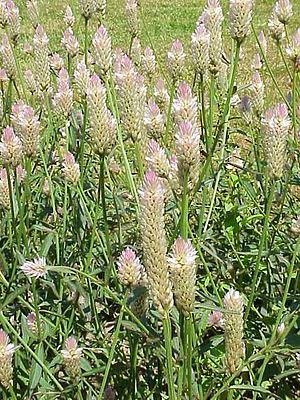Note: This is a project under development. The articles on this wiki are just being initiated and broadly incomplete. You can Help creating new pages.
Celosia argentea
Common cockscomb is an erect, usually much-branched, annual plant. It grows upto 40 - 200cm tall. This species is one of the most promising leaf crops for cultivation in poor or variable growing conditions. It is sometimes cultivated in western tropical Africa, and a few other areas of the tropics, for its edible leaves. It's family is Amaranthaceae.
Contents
- 1 Uses
- 2 Parts Used
- 3 Chemical Composition
- 4 Common names
- 5 Properties
- 6 Habit
- 7 Identification
- 8 List of Ayurvedic medicine in which the herb is used
- 9 Where to get the saplings
- 10 Mode of Propagation
- 11 How to plant/cultivate
- 12 Commonly seen growing in areas
- 13 Photo Gallery
- 14 References
- 15 External Links
Uses
Diarrhoea, Bloodshot eyes, Blurring of vision, Cataracts, Hypertension, Diabetes, Snakebites, Colic, Gonorrhoea, Eczema.
Parts Used
Chemical Composition
Common names
| Language | Common name |
|---|---|
| Kannada | Anne soppu, Hanne soppu |
| Hindi | Gadrya, Garke |
| Malayalam | |
| Tamil | Makili-k-kirai |
| Telugu | Gurugu |
| Marathi | Kurdu |
| Gujarathi | |
| Punjabi | |
| Kashmiri | |
| Sanskrit | Mayurasikha |
| English | Silver Cockscomb, White Cockscomb |
Properties
Reference: Dravya - Substance, Rasa - Taste, Guna - Qualities, Veerya - Potency, Vipaka - Post-digesion effect, Karma - Pharmacological activity, Prabhava - Therepeutics.
Dravya
Rasa
Guna
Veerya
Vipaka
Karma
Prabhava
Habit
Identification
Leaf
| Kind | Shape | Feature |
|---|---|---|
| Narrow | Elliptic | Strongly veined, 5-15cm long |
Flower
| Type | Size | Color and composition | Stamen | More information |
|---|---|---|---|---|
| Slender | 1-13cm | Pink | Rose flowers heads have a metallic sheen | {{{5}}} |
Fruit
| Type | Size | Mass | Appearance | Seeds | More information |
|---|---|---|---|---|---|
Other features
List of Ayurvedic medicine in which the herb is used
Where to get the saplings
Mode of Propagation
How to plant/cultivate
A plant of the tropics, able to be grown also in the subtropics and warm temperate zones.[4]
Commonly seen growing in areas
Photo Gallery
References
- ↑ [Chemistry]
- ↑ Karnataka Aushadhiya Sasyagalu By Dr.Maagadi R Gurudeva, Page no:11
- ↑ [Morphology]
- ↑ Cultivation
External Links
- Ayurvedic Herbs known to be helpful to treat Diarrhoea
- Ayurvedic Herbs known to be helpful to treat Bloodshot eyes
- Ayurvedic Herbs known to be helpful to treat Blurring of vision
- Ayurvedic Herbs known to be helpful to treat Cataracts
- Ayurvedic Herbs known to be helpful to treat Hypertension
- Ayurvedic Herbs known to be helpful to treat Diabetes
- Ayurvedic Herbs known to be helpful to treat Snakebites
- Ayurvedic Herbs known to be helpful to treat Colic
- Ayurvedic Herbs known to be helpful to treat Gonorrhoea
- Ayurvedic Herbs known to be helpful to treat Eczema
- Herbs with Leaves used in medicine
- Herbs with Young shoots used in medicine
- Herbs with common name in Kannada
- Herbs with common name in Hindi
- Herbs with common name in Tamil
- Herbs with common name in Telugu
- Herbs with common name in Marathi
- Herbs with common name in Sanskrit
- Herbs with common name in English
- Habit - Annual
- Index of Plants which can be propagated by Seeds
- Herbs that are commonly seen in the region of Open moist places
- Herbs
- Pages without herbs images





